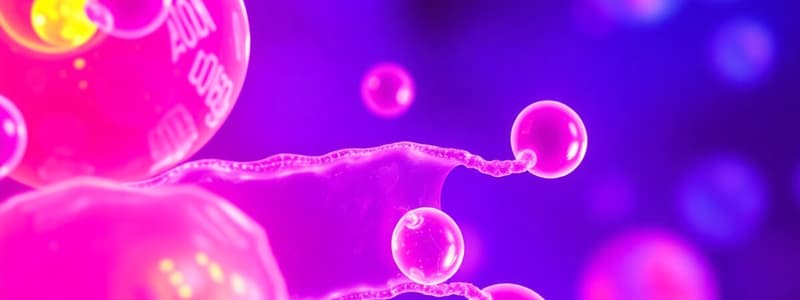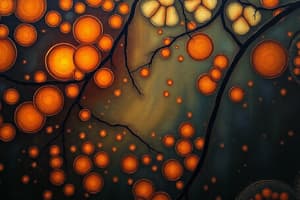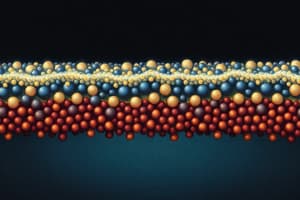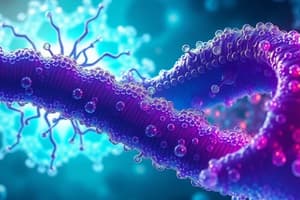Podcast
Questions and Answers
What is the name given to cell membranes?
What is the name given to cell membranes?
Biomembranes
The discovery of cell membranes was not related to the advancement of microscopic techniques.
The discovery of cell membranes was not related to the advancement of microscopic techniques.
False (B)
Biomembranes in all cells have the same chemical composition.
Biomembranes in all cells have the same chemical composition.
False (B)
What is the average thickness of the cytoplasmic membrane?
What is the average thickness of the cytoplasmic membrane?
What are the main functions of the cell membrane?
What are the main functions of the cell membrane?
What is the main component of cell membranes?
What is the main component of cell membranes?
Phospholipids are chemically bound to each other in the phospholipid bilayer.
Phospholipids are chemically bound to each other in the phospholipid bilayer.
Which of the following describes the types of proteins found in cell membranes?
Which of the following describes the types of proteins found in cell membranes?
Integral proteins can easily be separated from the biomembranes.
Integral proteins can easily be separated from the biomembranes.
Peripheral proteins can be easily separated from the biomembranes.
Peripheral proteins can be easily separated from the biomembranes.
The number and types of proteins found in a biomembrane is constant across all cells.
The number and types of proteins found in a biomembrane is constant across all cells.
What is the role of membrane proteins?
What is the role of membrane proteins?
Some membrane proteins are involved in the transport of ions across the membrane.
Some membrane proteins are involved in the transport of ions across the membrane.
Membrane proteins can never be involved in facilitated diffusion.
Membrane proteins can never be involved in facilitated diffusion.
Membrane proteins are never involved in receptor activity.
Membrane proteins are never involved in receptor activity.
Some membrane proteins can act as enzymes.
Some membrane proteins can act as enzymes.
Proteins and Glycolipids are never part of the antigens.
Proteins and Glycolipids are never part of the antigens.
What is the primary function of membrane receptors?
What is the primary function of membrane receptors?
How can membrane receptors be classified?
How can membrane receptors be classified?
Receptors that are part of ion channels can bind to cations and anions.
Receptors that are part of ion channels can bind to cations and anions.
Receptors with enzyme activity are only involved in catalyzing a limited number of reactions.
Receptors with enzyme activity are only involved in catalyzing a limited number of reactions.
G protein-coupled receptors represent a relatively small group of membrane receptors.
G protein-coupled receptors represent a relatively small group of membrane receptors.
What are the two basic mechanisms that regulate the transfer of substances into and out of cells?
What are the two basic mechanisms that regulate the transfer of substances into and out of cells?
What is passive transport?
What is passive transport?
What are the main types of passive transport?
What are the main types of passive transport?
The speed of passive transport is solely dependent on the size of the concentration gradient.
The speed of passive transport is solely dependent on the size of the concentration gradient.
Substances with low molecular weight can be transported across the cytoplasmic membrane via passive transport.
Substances with low molecular weight can be transported across the cytoplasmic membrane via passive transport.
What is active transport?
What is active transport?
Active transport relies on the movement of the membrane itself.
Active transport relies on the movement of the membrane itself.
Active transport is an example of a passive transport mechanism.
Active transport is an example of a passive transport mechanism.
Active transport involves the consumption of energy from the cell.
Active transport involves the consumption of energy from the cell.
What are the two basic types of active transport?
What are the two basic types of active transport?
Primary active transport is powered by the hydrolysis of ATP.
Primary active transport is powered by the hydrolysis of ATP.
How is primary active transport achieved?
How is primary active transport achieved?
What is an example of primary active transport?
What is an example of primary active transport?
Secondary active transport directly utilizes ATP hydrolysis to move substances.
Secondary active transport directly utilizes ATP hydrolysis to move substances.
How is secondary active transport achieved?
How is secondary active transport achieved?
Secondary active transport can be classified as either cotransport or antiport.
Secondary active transport can be classified as either cotransport or antiport.
What is endocytosis?
What is endocytosis?
Endocytosis is a passive transport mechanism.
Endocytosis is a passive transport mechanism.
Which of the following describes the main types of endocytosis?
Which of the following describes the main types of endocytosis?
What is pinocytosis?
What is pinocytosis?
What is phagocytosis?
What is phagocytosis?
What is exocytosis?
What is exocytosis?
Exocytosis is a passive transport mechanism.
Exocytosis is a passive transport mechanism.
Exocytosis involves the fusion of transport vesicles with the plasma membrane.
Exocytosis involves the fusion of transport vesicles with the plasma membrane.
What are cell organelles?
What are cell organelles?
How are cell organelles classified?
How are cell organelles classified?
Membrane-bound organelles consist of only one membrane.
Membrane-bound organelles consist of only one membrane.
The cytoskeleton is composed of proteins.
The cytoskeleton is composed of proteins.
Ribosomes are composed of proteins and nucleic acids.
Ribosomes are composed of proteins and nucleic acids.
What is the main function of mitochondria?
What is the main function of mitochondria?
Mitochondria are only found in prokaryotic cells.
Mitochondria are only found in prokaryotic cells.
Mitochondria are variable in shape and number depending on the cell type.
Mitochondria are variable in shape and number depending on the cell type.
The number of mitochondria in a cell is directly proportional to the intensity of the cell's energy metabolism.
The number of mitochondria in a cell is directly proportional to the intensity of the cell's energy metabolism.
Mitochondria have their own DNA and ribosomes.
Mitochondria have their own DNA and ribosomes.
Mitochondrial enzymes are exclusively synthesized on endoplasmic reticulum.
Mitochondrial enzymes are exclusively synthesized on endoplasmic reticulum.
What is the role of endoplasmic reticulum?
What is the role of endoplasmic reticulum?
Endoplasmic reticulum is only found in plant cells.
Endoplasmic reticulum is only found in plant cells.
Endoplasmic reticulum is directly connected to the nucleus.
Endoplasmic reticulum is directly connected to the nucleus.
Endoplasmic reticulum is directly connected to the Golgi apparatus.
Endoplasmic reticulum is directly connected to the Golgi apparatus.
What are the two main types of endoplasmic reticulum?
What are the two main types of endoplasmic reticulum?
Rough endoplasmic reticulum is the site of protein synthesis.
Rough endoplasmic reticulum is the site of protein synthesis.
The ratio of rough to smooth endoplasmic reticulum in a cell is fixed.
The ratio of rough to smooth endoplasmic reticulum in a cell is fixed.
What is the role of smooth endoplasmic reticulum?
What is the role of smooth endoplasmic reticulum?
What is the function of sarcoplasmic reticulum?
What is the function of sarcoplasmic reticulum?
What is the role of the Golgi apparatus?
What is the role of the Golgi apparatus?
The Golgi apparatus is composed of a single flattened sac.
The Golgi apparatus is composed of a single flattened sac.
The Golgi apparatus is only involved in the packaging of proteins.
The Golgi apparatus is only involved in the packaging of proteins.
What is the role of lysosomes?
What is the role of lysosomes?
Lysosomes are formed in the smooth endoplasmic reticulum.
Lysosomes are formed in the smooth endoplasmic reticulum.
Vacuoles are only found in plant cells.
Vacuoles are only found in plant cells.
What is the main function of peroxisomes?
What is the main function of peroxisomes?
Peroxisomes are directly involved in cellular respiration.
Peroxisomes are directly involved in cellular respiration.
What is the main function of ribosomes?
What is the main function of ribosomes?
Ribosomes are only found in eukaryotic cells.
Ribosomes are only found in eukaryotic cells.
Ribosomes are composed of two subunits: a large subunit and a small subunit.
Ribosomes are composed of two subunits: a large subunit and a small subunit.
Ribosomes are directly involved in DNA replication.
Ribosomes are directly involved in DNA replication.
Flashcards
Cell Membrane Structure
Cell Membrane Structure
Cell membranes, also called biomembranes, have a trilaminar structure, primarily composed of a phospholipid bilayer with embedded proteins.
Phospholipid Bilayer
Phospholipid Bilayer
A two-layered arrangement of phospholipid molecules, forming the basic structure of cell membranes. Hydrophilic heads face the water inside and outside the cell, while hydrophobic tails face each other.
Integral Membrane Proteins
Integral Membrane Proteins
Proteins embedded within the phospholipid bilayer; often spanning the entire membrane, interacting with the hydrophobic tails. Difficult to remove.
Peripheral Membrane Proteins
Peripheral Membrane Proteins
Signup and view all the flashcards
Passive Transport
Passive Transport
Signup and view all the flashcards
Membrane Receptors
Membrane Receptors
Signup and view all the flashcards
Selective Permeability
Selective Permeability
Signup and view all the flashcards
Study Notes
Cell Membranes (Biomembranes)
- Cell membranes (biomembranes) are vital components of all cells.
- Their discovery is linked to advancements in microscopic techniques, especially transmission electron microscopy.
- A typical trilaminar structure was observed.
- Cell membranes have similar structures, with slight differences in chemical composition relating to cell differentiation and specialization.
Functions of Cell Membrane
- Every cell is surrounded by a cytoplasmic membrane separating intracellular and extracellular space.
- Average membrane thickness is 60-100 nm.
- The membrane is selectively permeable, maintaining dynamic equilibrium between the cell and its environment.
- It includes enzymes, receptors and transport proteins, signaling systems, and antigens.
- The membrane performs functions such as substance intake, signal interactions, and recognition.
- It's a vital part of many cellular organelles.
Main Components of Cell Membranes
- Phospholipids are the major components.
- A phospholipid molecule consists of a polar (hydrophilic) head and two non-polar (hydrophobic) fatty acid tails.
- In an aqueous environment, the hydrophilic heads of phospholipids are oriented towards water, while the hydrophobic tails point inwards, creating a phospholipid bilayer.
- Phospholipids are chemically independent, enabling lateral movement.
Other Important Components of Biological Membranes
- Integral proteins: embedded within, or spanning the bilayer, affecting its hydrophobic sections; difficult to separate from the membrane.
- Peripheral proteins: situated outside the bilayer linked by ionic bonds; easily isolated from the membrane.
- Protein type and number vary dependent on cellular differentiation and cell cycle phase.
- Cell regulation controls the specific membrane protein composition.
Functions of Membrane Proteins
- Membrane proteins perform diverse functions.
- Some act as structural components (structural proteins).
- Others facilitate ion transport across the membrane (pumps and ion channels).
- Some facilitate substance movement along electrochemical gradients (facilitated diffusion).
- Many act as receptors binding hormones, neurotransmitters, and signals.
- Some proteins serve as enzymes.
- Membrane proteins and glycolipids contribute to the formation of antigens.
Membrane Receptors
- Membrane receptors are protein structures in the cell membrane.
- Their function is recognizing and binding signal molecules (e.g., hormones, neurotransmitters).
- The membrane interacts with its surroundings.
- Receptor types include those that are part of ion channels, receptors with enzymatic activity, and receptors coupled to G proteins (the largest family).
Transport of Substances Through the Membrane
- Transfer of substances into or out of cells is facilitated by two basic mechanisms:
- Passive transport
- Active transport
Passive Transport
- Passive transport involves substance movement along the concentration gradient without energy expenditure.
- The speed of transport is determined by the concentration gradient and the size of the substance.
- Substances with low molecular weight (e.g., water, oxygen, carbon dioxide, urea, methanol, ethanol) are transported this way.
- Diffusion is an unordered movement of dissolved molecules from high to low concentration across the membrane until equilibrium is reached.
- Osmosis exemplifies passive transport.
Osmosis
- Osmosis is the movement of water across a selectively permeable membrane from an area of high water concentration to one of low water concentration until equilibrium is reached.
- Hypertonic solutions have higher solute concentrations outside the cell than inside, causing water to exit and cell shrinkage.
- Hypotonic solutions have lower solute concentrations outside the cell than inside, causing water to enter and cell swelling.
- Isotonic solutions have equal solute concentrations inside and outside the cell, leading to no net water movement.
Facilitated Diffusion
- Facilitated diffusion is a form of passive transport employing plasma membrane proteins for substance movement across a concentration gradient without energy input.
- The transport protein binds the substance and undergoes conformational change, releasing it into the cytoplasm. Glucose transport is a good example.
Active Transport
- Active transport moves substances against a concentration or electrochemical gradient using cellular energy (ATP).
- Systems like channels and pumps transport proteins through the membrane.
- It's a selective and controlled process often regulated by receptors.
- Primary active transport: Utilizes direct ATP hydrolysis to change transport protein's conformation facilitating the movement of substances against their gradient (e.g. Na+-K+ pump, H+ pump).
- Secondary active transport: couples the movement of one substance along its gradient to the movement of another substance against its gradient (e.g. cotransport, antiport).
Endocytosis and Exocytosis
- Endocytosis and exocytosis facilitate transport of large molecules.
- Endocytosis: Transports molecules from outside the cell into vesicles within the cytoplasm.
- Pinocytosis: movement of fluids and small dissolved substances into the cell.
- Phagocytosis: movement of solids, large particles, or cells into the cell.
- Exocytosis: Transports molecules from the vesicles within the cell to the outside.
Cell Organelles
- Cytoplasm is the semi-fluid medium inside the cell, primarily composed of water and various organic and inorganic components.
- Eukaryotic cells include various organelles, categorized by their membrane composition.
- Organelles with one membrane include endoplasmic reticulum, Golgi apparatus, lysosomes, peroxisomes, and vacuoles.
- Organelles with two membranes include mitochondria and chloroplasts.
- Additional organelles consist of proteins (cytoskeleton - microtubules, microfilaments, and intermediate filaments; flagella and cilia) and nucleic acids (ribosomes and nucleolus).
Mitochondria
- Mitochondria are essential organelles involved in energy production in eukaryotic cells.
- They generate energy by breaking down organic molecules.
- Number and shape vary based on cell type.
- They possess two membranes: an outer membrane and an inner membrane with cristae (folds) to maximize surface area.
- ATP (adenosine triphosphate) synthesis occurs in the inner membrane.
- Mitochondria contain their own DNA and ribosomes.
Endoplasmic Reticulum
- Endoplasmic reticulum (ER) is a network of membranes (tubules and cisterns) linked to the nuclear membrane.
- It plays a crucial role in protein and lipid synthesis and is involved in compartmentalization within the cell.
- Two types of ER are distinguished based on structure and function:
- Rough ER: Studded with ribosomes, responsible for protein synthesis.
- Smooth ER: Lacks ribosomes and deals with lipid production, steroid hormone synthesis, and detoxification.
Golgi Apparatus
- Golgi apparatus modifies, packages, and sorts proteins and lipids produced by the ER, often repackaging and targeting them to specific locations.
- Composed of stacks of flattened membranes (cisternae).
- Post-translational modifications of proteins in Golgi are performed.
Lysosomes and Vesicles
- Lysosomes containing enzymes for digestion of materials internalized via endocytosis.
- They break down excess or worn-out organelles, cellular debris.
- They play a critical role in cell apoptosis.
Peroxisomes
- Peroxisomes are single-membrane-bound organelles containing enzymes, especially catalase, for detoxification and lipid metabolism.
Ribosomes
- Ribosomes are essential particles responsible for protein synthesis in cells.
- They consist of large and small subunits.
- They may be free in the cytoplasm or bound to the rough ER.
Studying That Suits You
Use AI to generate personalized quizzes and flashcards to suit your learning preferences.




